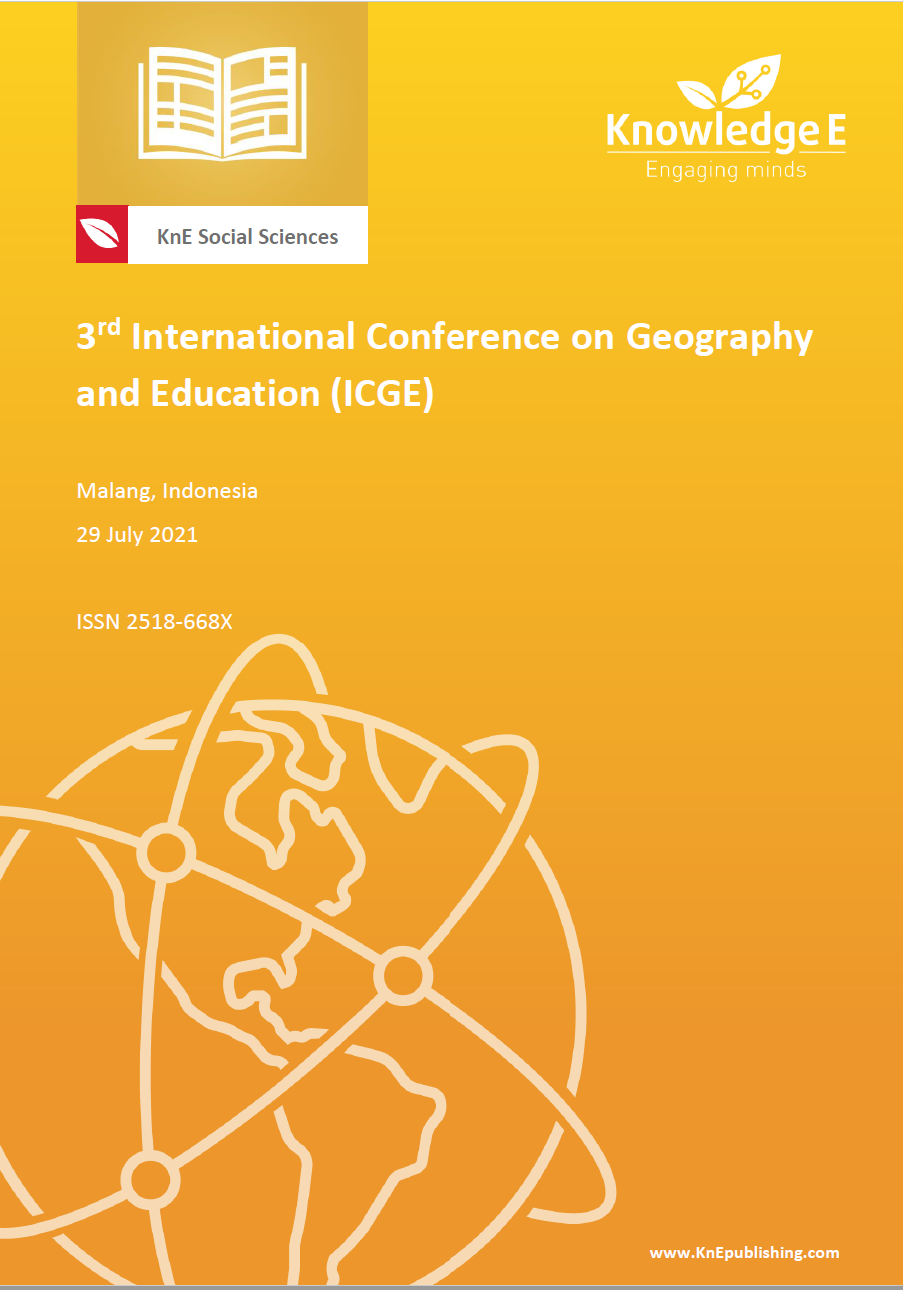The Effect of Vegetation Density on Land Surface Temperature in Klojen District
DOI:
https://doi.org/10.18502/kss.v7i16.12186Abstract
Due to its increased population, the Klojen District has become the center of government and economy in Malang City. Overpopulation has caused an increase in land conversion and a decrease in vegetation area, resulting in the Urban Heat Island effect or increased land surface temperature (LST) in urban areas. This study aimed to determine the effect of the normalized difference vegetation index (NDVI) on LST in the Klojen District. The data were processed by interpreting Landsat 8 satellite imagery using NDVI and LST analyses in 2018 and 2020, and the two variables were tested for linear regression. The regression test results showed that the NDVI and LST in 2018 and 2020 had a negative correlation. The data indicated that as vegetation density increased, the LST decreased, and vice-versa. According to the NDVI-LST coefficient of determination value, the correlation in 2020 was higher than in 2018, indicating that the NDVI-LST correlation became stronger every year with a coefficient of determination value between 0.67 and 0.81.
Keywords: vegetation density, land surface temperature, NDVI
References
Adeanti M, Harist MC. Analisis spasial kerapatan bangunan dan pengaruhnya terhadap suhu studi kasus di kabupaten bogor (Spatial analysis of building density and its effect on temperature case study in Bogor Regency). Seminar Nasional Geomatika. 2019;3:529-536.
Arikunto S. Metode peneltian. Jakarta: Rineka Cipta; 2010.
Azwar S. Metode penelitian. Yogyakarta: Pustaka Pelajar; 2010.
Badan Pusat Statistik. Kota Malang dalam angka 2021. Malang: Badan Pusat Statistik; 2020.
Bhang KJ, Lee JD. Consideration of NDVI and surface temperature calculation from satellite imagery in urban areas: A case study for Gumi, Korea. Journal of the Korean Society of Surveying, Geodesy, Photogrammetry and Cartography. 2017;35(1):23-30.
Buyantuyev A, Wu J. Urbanization alters spatiotemporal patterns of ecosystem primary production: A case study of the Phoenix metropolitan region, USA. Journal of Arid Environments. 2009;73(4-5):512-520.
Dede M, Pramulatsih GP, Widiawaty MA, Ramadhan YRR, Ati A. Dinamika suhu permukaan dan kerapatan vegetasi di Kota Cirebon (Changes in surface temperature and vegetation density in Cirebon City). Jurnal Meteorologi Klimatologi dan Geofisika. 2019;6(1):23-31.
Franklin SE. Remote sensing for sustainable forest management. Florida: CRC Press LLC; 2011.
Guha S, Govil H. An assessment on the relationship between land surface temperature and normalized difference vegetation index. Environment, Development and Sustainability: A Multidisciplinary Approach to the Theory and Practice of Sustainable Development. 2021;23(2):1944-1963.
Indrawati DM, Suharyadi S, Widayani P. Analisis pengaruh kerapatan vegetasi terhadap suhu permukaan dan keterkaitannya dengan fenomena UHI (Effect of vegetation density on surface temperature related to UHI phenomenon). Media Komunikasi Geografi. 2020;21(1):99-109.
Peraturan menteri kehutanan Republik Indonesia nomor P.12/Menhut-Ii/2012. Perubahan kedua atas peraturan menteri kehutanan nomor P.32/Menhut-Ii/2009 tentang tata cara penyusunan rencana teknik rehabilitasi hutan dan lahan daerah aliran sungai (RTK RHL-DAS) (Second amendment to the regulation of the Minister of Forestry Number P.32/Menhut-II/2009 concerning procedures for compiling technical plans for the rehabilitation of forests and watershed lands). Berita Negara Republik Indonesia tahun 2012 nomor 296. Jakarta: Berita Negara Republik Indonesia; 12 Maret 2012.
Prasetya TAE, Munawar M, Taufik MR, Chesoh S, Lim A, McNeil D. Land surface temperature assessment in Central Sumatra, Indonesia. Indonesian Journal of Geography. 2020;52(2):227-238.
Pratama MR, Rachmansyah A, Usman F. Pemodelan dinamis kebutuhan ruang terbuka hijau kota Malang. Indonesian Green Technology Journal. 2016;5(1):7–15.
Solihin MA, Putri N, Setiawan A, Siliwangi D, Arifin M. Karakteristik indeks vegetasi pada berbagai penggunaan lahan di hulu sub DAS Cikapundung melalui interpretasi citra satelit Landsat 8 (Characteristics of the vegetation index on various land uses in the upstream Cikapundung sub-watershed through the interpretation of Landsat 8 satellite imagery). Kultivasi. 2020;19(3):1202-1209.
Tatisina NN, Siahaya WA, Haumahu JP. Transformasi indeks vegetasi Citra LANDSAT 8 OLI untuk pemetaan musim tanam pada lahan sawah di kabupaten buru, Provinsi Maluku. Jurnal Budidaya Pertanian. 2020;16(2):197-205.
Utomo AW, Suprayogi A, Sasmito B. Analisis hubungan variasi land surface temperature dengan kelas tutupan lahan menggunakan data citra satelit landsat (Studi kasus: Kabupaten Pati) (Analysis of the relationship between variations in land surface temperature and land cover class using Landsat satellite image data (Case Study: Pati Regency)). Jurnal Geodesi Undip. 2017;6(2):71-80.
Wiguna DP. Identifikasi suhu permukaan tanah dengan metode konversi digital number menggunakan teknik penginderaan jauh dan sistem informasi geografis (Identification of soil surface temperature using digital number conversion method using remote sensing techniques and geographic information systems). Jurnal Teknologi Informasi dan Komunikasi. 2017;6(2):59-69.
Wiguna DP, Sonata F. Kondisi suhu permukaan tanah wilayah perkotaan menggunakan citra satelit Landsat 8 (Studi kasus: Mebidang) (Land surface temperature conditions in urban areas using Landsat 8 satellite imagery (Case study: Mebidang District)). J-SISKO TECH ( Jurnal Teknologi Sistem Informasi dan Sistem Komputer TGD). 2018;1(2):60-74.
Wulandari N. Penggunaan metode NDVI (normalized difference vegetation index) dan SAVI (soil adjusted vegetation index) untuk mengetahui ketersediaan ruang terbuka hijau terhadap pemenuhan kebutuhan oksigen (Studi kasus: Kota Yogyakarta) (The use of NDVI (normalized difference vegetation index) and SAVI (soil adjusted vegetation index) methods to determine the availability of green open space to fulfill oxygen needs (Case study: Yogyakarta City)) [Doctoral dissertation]. Institut Teknologi Nasional Malang; 2020.

